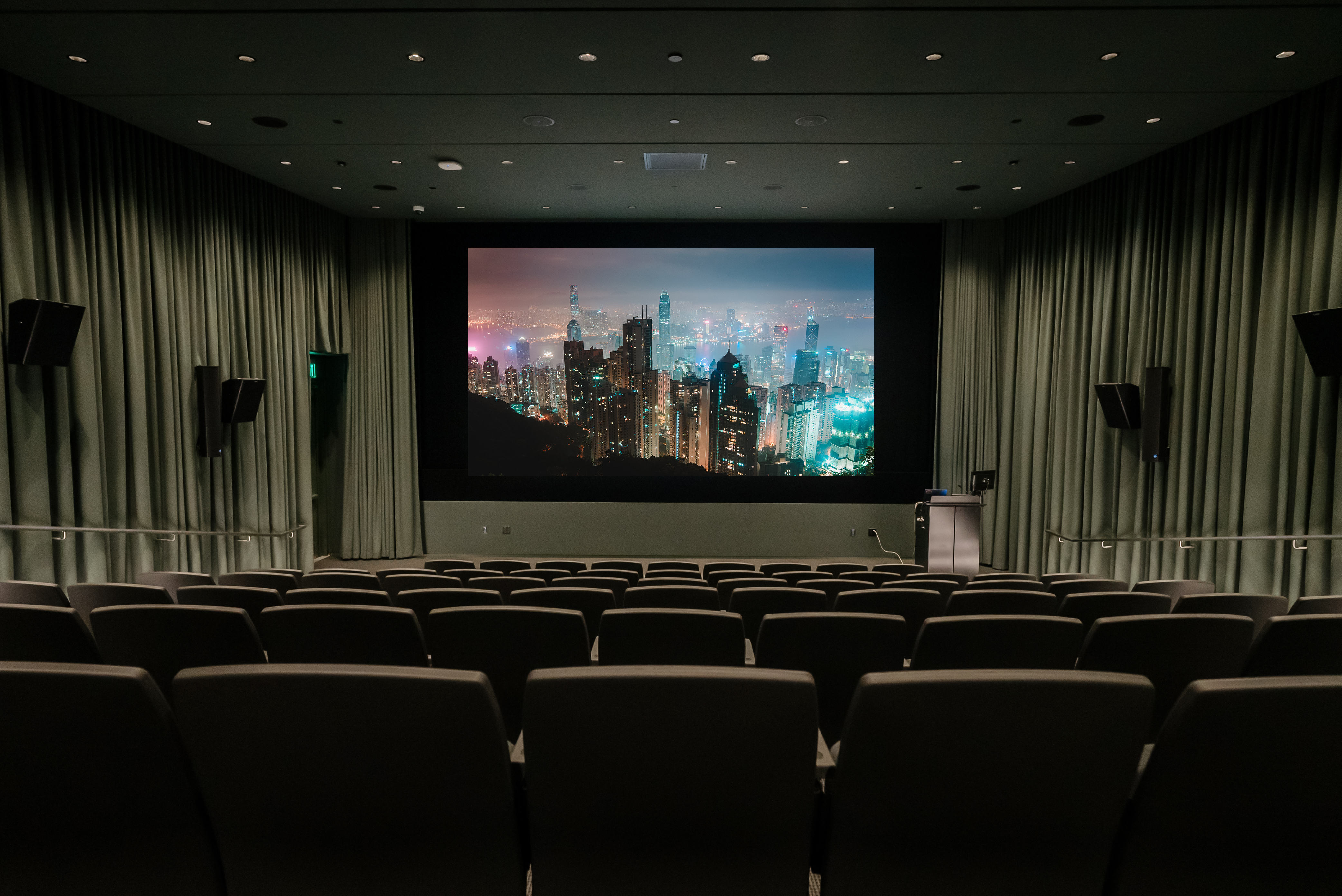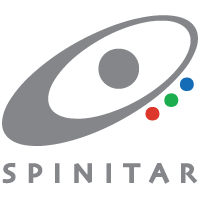Case Study: LMU SFTV
The Client

The Howard B. Fitzpatrick Pavilion at Loyola Marymount University opened its doors in the Fall of 2021 and serves as an extension to their prestigious School of Film and Television, which is ranked 8th in the nation by The Hollywood Reporter. The new facility includes eight room types including, modern instructional classrooms, innovative production labs, a large lecture hall/ 85-person theatre, and creative workspaces for faculty and staff. LMU’s School of Film and Television is ‘designed to foster original and creative work in film and television production and writing’.
The Challenge
With growth, comes the need for expansion, and expanding is exactly what LMU executives decided to do to accommodate the demand of their film and television programs.
Built from the ground up, Spinitar worked closely with the projects AV consultant, Waveguide, and LMU’s IT department to determine a plan that would fulfill the universities goals, timeline, and budget for the new facility.
Tasked with sourcing and installing the technology that would be integrated into the building, Spinitar relied heavily on their manufacturing partners to acquire the products needed to fulfill the AV solutions in each room.
Despite product shortages, due to Covid-19, Spinitar was able to successfully source all of the technology needed to complete the $1 million AV integration component.
The Approach
Using updated technology, LMU SFTV had its sights set on bringing students closer together, while also building a sense of community.
To help accomplish their goals, Spinitar implemented a unified communication solution that would support collaboration, ignite creativity, and serve as a reliable and easy-to-use system that would advance student engagement and participation.

I think the updated technology in all of the rooms helps us be at the cutting edge of new developments in the field of film & media.
Carla Marcantonio
Associate Dean for Academic Affairs, Loyola Marymount University, SFTV
The Technology
Spinitar was aware of current issues related to existing technological infrastructures. Prior to beginning the project, existing equipment lacked the technical capabilities required for company growth and expansion. Although current accommodations worked for smaller teams, a number of technical issues existed. Microphones and insufficient computer hardware caused individuals to become frustrated and inundated with mindless tasks. Furthermore, existing equipment and sporadic technical components created frustration amongst leaders.
In collaboration with Happy Money, Spinitar used their years of AV integration experience and design expertise to create highly functional yet sophisticated and innovative technological solutions. This gave Spinitar the creative flexibility to implement a design geared towards Happy Money’s specific business needs.
Since Happy Money was moving into a brand new office building and was the first company to occupy the space—it was easier for Spinitar to create designs with specifications geared towards company objectives and goals. With a heavy emphasis centered around automated functionality, Spinitar attempted to make the interface as straightforward as possible.
The following technologies were implemented throughout the new Happy Money office space facility:
Each of the rooms contain a 65” mounted Samsung commercial grade display monitor.
Creston Mercury devices with built-in VoIP functionality were used with swivel mounts integrated directly into the table.
Cameras were then attached to the bottom of displays and USB/HDMI extenders were used for connectivity from the Mercury devices at the table to the displays on the wall.
Each room received a 55” Samsung wall mounted display.
Creston Mercury devices with built-in VoIP functionality were used with swivel mounts integrated directly into the table.
Cameras were then attached to the bottom of displays and USB/HDMI extenders were used for connectivity from the Mercury devices at the table to the displays on the wall.
The All Hands area consisted of a 4x4 video wall which utilizes (16) 55” LCD monitors mounted to form a 165” diagonal display with (8) dedicated electrical circuits.
A 24 port network switch and (1) POE+ injector facilitates the networking side of the equipment and is well hidden inside a credenza rack underneath the video wall.
The audio consists of (4) JBL speaker line arrays which were floated from multiple I-Beams along with a DSP for line level mixing, zone control, and equalization.
The lighting is made up of (4) Martin LED lights mounted to lighting pipes attached to I-Beams in front of the stage.
An in-wall transmitter is provided to allow for quick local display of video and a nearby in-wall video transmitter allows for plug and play of a local video source. By distributing this feed back to the MDF and into the NVX matrix, this allows the feed from the All Hands area to be routed to any other signage displays in the building. This includes any display on a separate floor or even the video wall in the Reception area.
A white Crestron 10” touch panel is mounted in-wall nearby to provide control of the whole system for on/off functionality, volume, microphone selection and lighting control.
Additionally an external iPad was provided which mirrors the in-wall touch panel and allows for wireless control from anywhere in the room.
The conference room was outfitted with an 82” wall mounted Samsung commercial LED display and a Vaddio 30x PTZ USB camera.
A Shure MXA910 in-ceiling microphone was used in conjunction with a Crestron sound bar allowing for VoIP calling and echo cancellation.
A white 10” table mounted touch panel allows for control of systems on/off, microphone muting, audio volume control, camera adjustment and VoIP call dialing.
The Experience Center is a two way combinable room.
Each room consists of a 2x2 video wall which utilizes (4) 55” LCD monitors mounted to form a 110” diagonal display.
USB PTZ cameras were installed next to each display to allow for video conferencing sessions.
The audio is made up of (1) Shure MXA910 in-ceiling microphone which is pole-mounted to the ceiling along with (8) Crestron pendant speakers in each room.
When combined both rooms act as one utilizing all (16) speakers and both Shure MXA910 microphones in conjunction with each other.
Each video wall mirrors the other depending on which room you select a source from.
The system is controlled by (2) Crestron 10” wall mounted touch panels, one for each side of the space.
Additionally an external iPad was provided which mirrors the control panels and allows for wireless control from anywhere in the room.
An 82” wall mounted commercial grade Samsung display was used along with Creston Mercury devices with swivel mounts integrated into the tables. The Mercury simultaneously acts as both the speakers and microphone while an HD Huddly GO camera is attached to the bottom of the display in the front of the room.
An Intel NUC with bluetooth capabilities functions as the processor in these spaces and acts as the Zoom Rooms hub.
An 82” wall mounted commercial grade Samsung display was used along with (8) Crestron pendant speakers.
This area functions as one of the main controllable zones for background music which utilizes a Sonos Connect box on the network, one of four distributable background music sources that can be changed on the fly throughout the building.
The reception area contains a 2x2 video wall which utilizes (4) 55” LCD displays mounted to form a 110” diagonal display.
A nearby in-wall video transmitter allows for plug and play of a local video source. By distributing this feed back to the MDF and into the NVX matrix, this allows the feed from the Reception area to be routed to any other signage display in the building. This includes any display on a separate floor or even the All Hands video wall.
A 10” in-wall touch panel is used for control to turn the wall off/on, select a source and control volume levels for the speakers.
The room consists of (4) 40” wall mounted commercial grade Samsung displays and (4) HDMI input wall plates for local plug and play at each display.
A 55” wall mounted commercial grade Samsung display was used in the area. This location also acts as part of the distributed digital signage destinations and can be controlled wirelessly via an iPad.
A total of (13) 65” wall mounted commercial grade Samsung displays were used along with 2 NVX Encoding/Decoding card frames and (16) NVX box decoders located at each digital signage location (This includes the All Hands Space, Reception area and Coffee Bar).
A total of (4) BrightSign media players are used for signage content management along with a Mac Mini, while (4) mobile iPads act as the main interface for control of the signage locations.
The system was set up with user friendly “pick and poke” routing for simple management of all content. Simply pick a source and then pick a destination to route the desired content. If a display is off it automatically turns on. A scheduling system can also be put into place to have all displays turn on and off at specified times of the day.
A total of (112) speakers were used along with an (8) channel QSC digital amplifier and a (12) channel Biamp DSP.
Audio systems consist of (5) audio decoder cards, (1) paging microphone station, and (4) Sonos players.
There are a total of (7) speaker zones that can be controlled from touch panels on the 3rd and 4th floors with optional passcode protection.
A well engineered Biamp/Cambridge sound masking system is used in the 4th floor open office areas to allow for noise management between the call centers and private office areas.
The Solution
The new facility operates via Crestron-based technologies in support of Zoom collaboration solutions, making it easy for faculty and students to operate in a hybrid learning environment.
Completed in just 9-months, the audiovisual technology implemented into the facility enables students to share their own unique stories using innovative technology.



